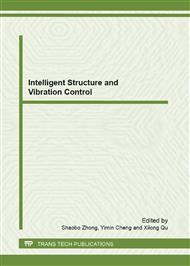p.806
p.812
p.818
p.823
p.828
p.833
p.838
p.843
p.849
Modal Parameters Identification Based on Noise Cancellation from Measured Vibration Response Signals
Abstract:
Measured vibration response signals are inevitably contaminated with noise when a data acquisition system is used for an experimental measurement. This situation often leads to serious difficulties in identifying the modal parameters with proper accuracy. This paper presents a noise cancellation method for measured impulsive response functions (IRFs) based on structured low rank approximation (SLRA) so as to improve the accuracy of the modal parameters identification. Numerical study of a cantilever beam model is carried out to demonstrate the performance of the proposed method. The results show that this method can remove noise from measured IRFs efficiently, and the modal parameter identifications based on the filtered IRFs are very good.
Info:
Periodical:
Pages:
828-832
Citation:
Online since:
February 2011
Authors:
Price:
Сopyright:
© 2011 Trans Tech Publications Ltd. All Rights Reserved
Share:
Citation:


